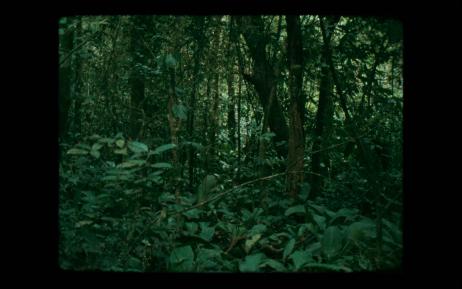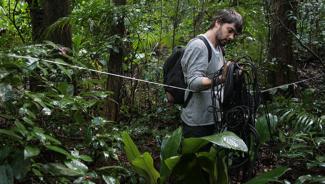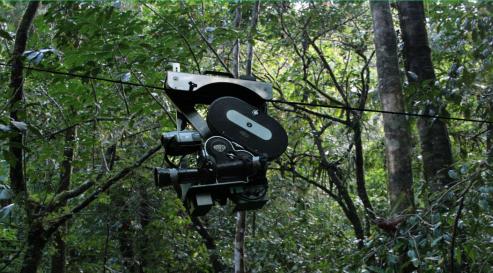
Daniel Steegmann Mangrané
Exhibition from 02 Dec to 19 Dec 2015
10 years and 1 months ago
At first glance, there isn’t much to see. A visitor wearing a display headset, the Oculus Rift, connected vertically, turns blindly and seems to be watching a virtual world made for his eyes only. From December 2 to 19 2015, the artist Daniel Steegmann Mangrané presents 16 MM, an installation especially conceived for the Lafayette Anticipations Hub.
Phantom
When your turn comes, you put the oculus on your head and then a landscape opens up, fringed with a pristine forest that is limitless, incommensurable. Every twig, every leaf, every bush is rendered in white stereoscopic stipples on black, a spatialised mapping of the infinite diversity of a universe in which nature alone has dictated the laws and set up ancient balances. The technical device follows your footsteps, and when you point your eyes upward, you are in the middle of a tree, where you see all of its branching from the inside. Your watching body crosses environments and vanishes, like a pure spirit, a consciousness capable of perceiving everything in the ecosystem’s magnificently complex structures, but without the power to change them. Daniel Steegmann Mangrané, a Brazilian artist of Catalan extraction, performed a high-precision 3D scan of around 1000 square metres in the middle of a pristine forest in south-west Brazil, the Mata Atlântica. His installation Phantom (Kingdom of All Animals and All Beasts in My Name), 2015, is above all – for those who get taken in by the vertigo of contemplation – the experience of a “self” consciousness, a kingdom that mixes all surrounding living things, like a gigantic network of invisible energies.
Multinaturalism
The young Daniel Steegmann Mangrané seemed destined for a career as a biologist. His work finds expression through a wide range of techniques and scales, including film, sculpture, installation and landscape intervention. His thinking has never really strayed from this initial passion for nature. And when he went to Brazil, his only aim was to get closer too the Amazon forest, which had always fascinated him unlike anything else. It is not only the observation of natural phenomena that fascinates the artist, but also getting closer to different conceptions of life. He often refers to the writings of Brazilian anthropologist and philosopher Eduardo Viveiros de Castro, known for his theory of “multinatural perspectivism” (1), based on the beliefs of Amerindians such as the Tupi people of southern Brazil, for whom everything is human: the common denominator shared by all forms of life is humanity, and not animality. In fact, there is no distinction between oneself and all that surrounds one; a kind of spiritual unity served by a corporeal diversity. The binary opposition between object and subject, between nature and culture, which has been regulating our Western way of thinking since the Enlightenment, no longer obtains. In other words, perceiving means entering into an understanding of the world that illuminates the reciprocal humanity in everything.
Mimesis
The artist also quotes Roger Caillois’s mythical text, Mimicry and Legendary Psychasthenia, which appeared in a 1935 issue of the surrealist magazine Le Minautore, in which the author discusses the mimetic function of certain insects, describing it not as a passive defence mechanism, but as an asserted will to blend in with the environment, to become “one” with the world. In his 2012 film Phasmides, Daniel Steegmann Mangrané evokes this thought. Stick insects, those twig-like insects so well described by Georges Didi-Hubermann (2), are evolving in a space shared by branches and sharp-edged modernist structures. In this enclosure with antagonistic shapes, we follow the behaviour of insects that are slowly attempting to invent a new mimetic ecology.
Phenomenology
We know the extent to which the subject of perception is fundamental for the artist. The environment, a word often used to characterise our fragile shared destiny, requires above all that we apply a consciousness to all our surroundings that physically engages us in a projection, a displacement, a healthy alienation. When it was first exhibited in France, the installation Orange Orange 2 (2004) appeared in a space bathed in “summer blue”, presenting a structure covered in orange photographic filters, inside of which orange juice was served. How does colour influence our understanding of the world, through vision, displacement to the point of absorption?
Several versions of a work with an unpronounceable title, (‘(^ , 2008, have already been exhibited. It consists of curtains of fine, coloured chains, from which shapes hang, creating a row of openings. The visitor is invited to cross the work, observing the changing nature of the chromatic phenomena perceived in relation to his or her own displacement, leading the visitor to develop a dynamic relationship of mutual transformation with the work of art.
Lines
The work Equal (Cut), 2008 is an intervention at the entrance to an alternative art space in Rio, Ateliê397. The artist cut the ground with a rotary saw, creating a groove which diagonally crossed the small inner courtyard and continued into the building, and in which weeds grew, like a linear rhizome.
The film installation entitled 16 MM, 2009-11, also involves the imposition of a straight line, but this time in the middle of nature. Through the same block of Amazon forest described above in relation to the work Phantom, the artist stretched a cable measuring 60.96 metres, the exact length of the film on a standard 16-mm reel. The suspended camera slides along the cable at the same speed at which the film rolls through the camera. Our perception of the images and sounds that reproduce the intense swarming of a forest indifferent to our observation is perfectly in conjunction with the mechanical unreeling of the images. The visitor is gripped by the tumultuous, spellbinding life, by the myriad of sounds and shapes where survival is only possible in the balance and reciprocity of forces, something that for Daniel Steegmann Mangrané – beyond the fascination with the laws of nature – also offers the new model of a possible society of sharing.
1 - Eduardo Viveiros De Castro, “Perspectivisme et multinaturalisme en Amérique indigène”, Journal des anthropologues, 2014
2 – Georges Didi-Hubermann, Phasmes , Essai sur l’apparition, Les Éditions de Minuit, 1998
3 – The exhibition Animal que no existeix, Daniel Steegmann Mangrané, CRAC, Centre Rhénan d’art Contemporain, Alsace, 19 October 2014 to 18 January 2015, Curator: Elfi Turpin.

